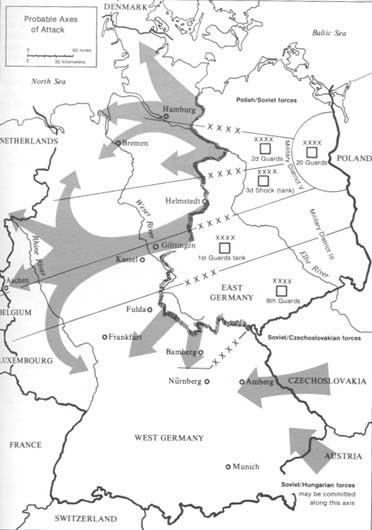 | ||
Would be carried out in response to a NATO first strike on Poland. Such a strike was estimated to cause 2,000,000 immediate Polish deaths near the Vistula river. If carried out, heavy losses in West Germany. | ||
Seven Days to the River Rhine was a top-secret military simulation exercise developed in 1979 by the Warsaw Pact. It depicted the Soviet bloc's vision of a seven-day nuclear war between NATO and Warsaw Pact forces.
Contents
Declassification
This possible World War III scenario was released by the conservative Polish government following their election in 2005, in order to "draw a line under the country's Communist past", and "educate the Polish public about the old regime."
Radosław Sikorski, the Polish defense minister at the time the documents were released, stated that documents associated with the former regime would be declassified and published through the Institute of National Remembrance in the coming year.
The files released included documents about "Operation Danube", the 1968 Soviet invasion of Czechoslovakia. They also included files on the 1970 Polish protests, and from the martial law era of the 1980s.
The Czechs and Hungarians had declassified related documents in the 1990s.
Battle outline
The scenario for the war was NATO launching a nuclear attack on Polish cities in the Vistula river valley area in a first-strike scenario, as well as Czech cities, which would prevent Soviet bloc commanders from sending reinforcements to East Germany to forestall a possible NATO invasion of that country. The plan expected that as many as two million Polish civilians would die in such a war and Polish operational strength would be completely destroyed.
A Soviet nuclear counter-strike would be launched against West Germany, Belgium, the Netherlands and Denmark .
NATO initiating the conflict might have been a politically palatable cover for what might have been an offensive plan. This is seen in many NATO and USSR war game scenarios.
Nuclear response
Maps associated with the released plan show nuclear strikes in many NATO states, but exclude both France and the United Kingdom. There are several possibilities for this lack of strikes, the most probable being that both France and the United Kingdom are nuclear weapons states, and as such retain nuclear arsenals that could be employed in retaliation for nuclear strikes against their nations.
The French forces employed a nuclear strategy known as dissuasion du faible au fort (weak-to-strong deterrence); this is considered a "counter-value" strategy, which implies that a nuclear attack on France would be responded to by a strike on Russian cities. See Force de frappe for more information on the French conceptualization of nuclear warfare.
The Guardian newspaper, however, speculates that "France would have escaped attack, possibly because it is not a member of NATO's integrated structure. Britain, which has always been at the heart of NATO, would also have been spared, suggesting Moscow wanted to stop at the Rhine to avoid overstretching its forces."
There are many high-value targets in Britain (like RAF Fylingdales, RAF Mildenhall and RAF Lakenheath) that would then have to be struck in a conventional manner in this plan, though a nuclear strike would be far more effective (and, as the plans show, a preferable option for the Soviet leadership as shown by their strikes in Western Europe). The plan also indicates that USAF fighter-bombers, primarily the long-ranged F-111, would be employed in nuclear strikes, and that they would launch from those British bases.
The Soviets planned to use about 7.5 megatons of atomic weaponry in all during such a conflict.
Known targets
Vienna was to be hit by two 500-kiloton bombs, while Vicenza, Verona, Padova and several bases in Italy were to be hit by single 500-kiloton bombs. Hungary was to capture Vienna and part of northern Italy after this had happened.
Stuttgart, Munich and Nuremberg in Germany were to be destroyed by nuclear weapons and then captured by the Czechoslovaks and Hungarians.
In Denmark targets would include Roskilde and Esbjerg. Roskilde, while having no military significance, would be targeted for its cultural and historical significance to break the morale of the Danish population and army, while Esbjerg would be targeted for its large harbour capable of facilitating delivery of large NATO reinforcements.
Additional plans
The Soviets planned to have reached Lyon by day nine and to press on to a final position at the Pyrenees. The Czechoslovaks thought it to be too optimistic at the time, and today's Western planners believe that such a goal was difficult or even unattainable. There were also plans of a naval operation in the North Atlantic against NATO shipping.
